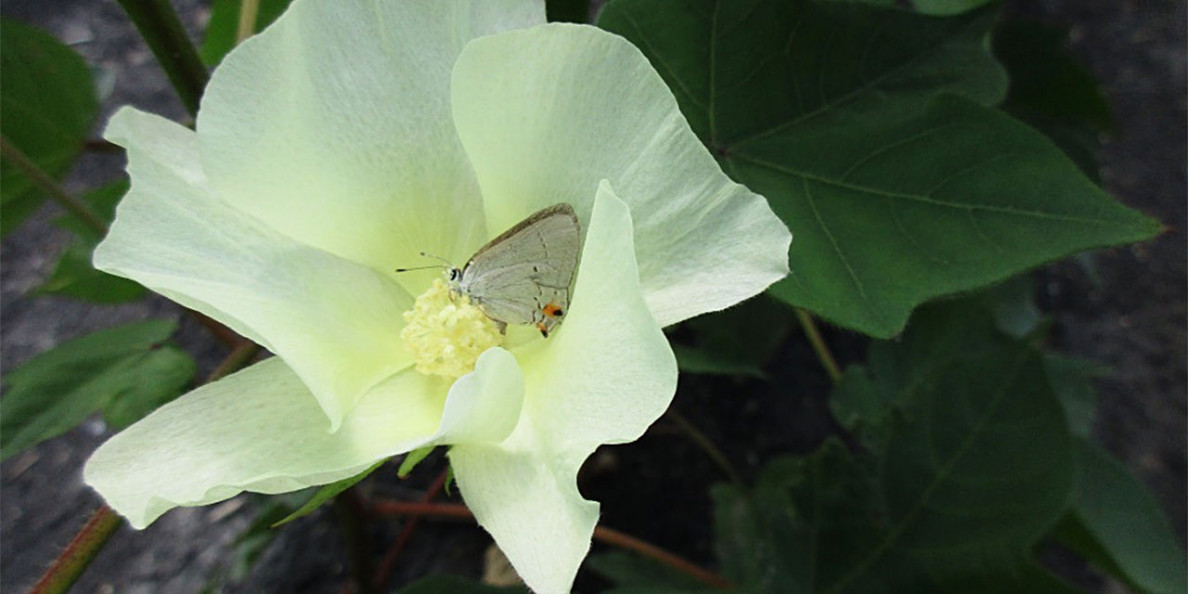Bees are great pollinators—and so important for crops such as almonds and apples that they’re driven in to farms and orchards by the truckload each spring. But when it comes to cotton, butterflies play an unexpected role. A new study suggests that by cross-fertilizing cotton flowers that bees don’t visit, other kinds of insects—principally hoverflies and butterflies—add about $120 million per year to the cotton harvest in Texas alone.
“This paper will drive people to look at the importance of butterflies as pollinators,” says Karen Oberhauser, a butterfly biologist at the University of Wisconsin, Madison, who was not involved in the research. If the results hold up in other crops, butterflies might be added to a short list of commercially important pollinators including honey bees, bumble bees, hoverflies, and beetles.
Until now, biologists haven’t rigorously examined butterfly pollination in agriculture. Butterflies aren’t as abundant as bees, and they don’t go out of their way to collect pollen. Unlike bees, whose hairy bodies are easily coated in the yellow dust, butterflies have long, delicate legs that seldom brush up against a flower’s pollen-producing anthers. When it comes to pollination, the dainty nectar sippers “have been scoffed at,” says Sarah Cusser, a landscape ecologist at the University of Vermont who conducted the new study.
Cusser studies how habitat and pollinator diversity contribute to agriculture. For her Ph.D. in landscape ecology at the University of Texas, Austin, she researched these factors in cotton. There was no shortage of field sites along the Gulf Coast. “You can stand on top of your car and see nothing but cotton,” she says.
To find out how well cotton was being pollinated, Cusser counted a lot of insects. Three times over 3 years, she slowly traversed 9 hectares of cotton fields, hunched over and looking for pollinators. She often went barefoot, because the mud would have sucked off her shoes. Each time Cusser saw an insect visiting a flower, she tried to capture it with a net and stow it in a vial of ethanol.
Back in the lab, she identified the insects—2444 in all—and the kind of pollen they were carrying. She had expected to find mostly honey bees. But she also frequently encountered a native bee, the long-horned bee, and she came across hundreds of flies and butterflies. All told, she counted 40 bee species, 16 fly species, and 18 butterfly species, including the gray hairstreak (Strymon melinus) and the little yellow (Eurema lisa). “I was really surprised by the awesome diversity of insects.”
That wasn’t her only revelation. Cusser noticed that various pollinators visited the flowers at different times throughout the day. Flies would be out early, perhaps because they tend to nest in the fields. Then, butterflies would arrive; by the time it got really hot, bees were out in force. Timing matters because each cotton flower is receptive to pollen for just a few hours and withers by sunset.
Cusser also discovered that various insects tended to visit different parts of the cotton plant. Bees preferred to forage on inner flowers, closer to the main stem (though it’s not known why). Flies and butterflies landed on outer flowers, possibly because they’re less nimble fliers. These preferences essentially mean roughly 50% more flowers are visited, thanks to flies and butterflies, than if bees were the only pollinators, Cusser and her advisers report this month in Agriculture, Ecosystems & Environment. “It was extraordinary, the extent of it,” Cusser says.
This phenomenon, which goes by the technical term pollination complementarity, isn’t unique to cotton. In almond orchards, wild bees and domesticated honey bees visit different parts of the trees. Complementarity could be more common than currently realized, Cusser says. “I find the whole idea fascinating,” Oberhauser says. “We just don’t give butterflies enough credit for their role.”
Granted, bees still do most of the work. In cotton fields, Cusser found they’re responsible for about 66% of the pollination. But the work of butterflies and flies still adds up to about $120 million per year of extra cash for cotton farmers in Texas, she estimates. “We kept joking that butterflies aren’t quite as useless as everyone thought they were.”
Cusser hopes the findings will encourage farmers to conserve or restore habitat that benefits the overlooked pollinators. As a postdoc at the University of Vermont, she plans to study whether habitat restoration benefits cotton farmers by boosting the diversity of pollinators.
“People value butterflies because they’re charismatic, and people can see them in their gardens, but now I can point to them as pollinators and know that they can have a significant effect,” says Nick Haddad, a butterfly biologist at Michigan State University and co-author. “It really has changed my world.”
Πηγή: sciencemag.org

